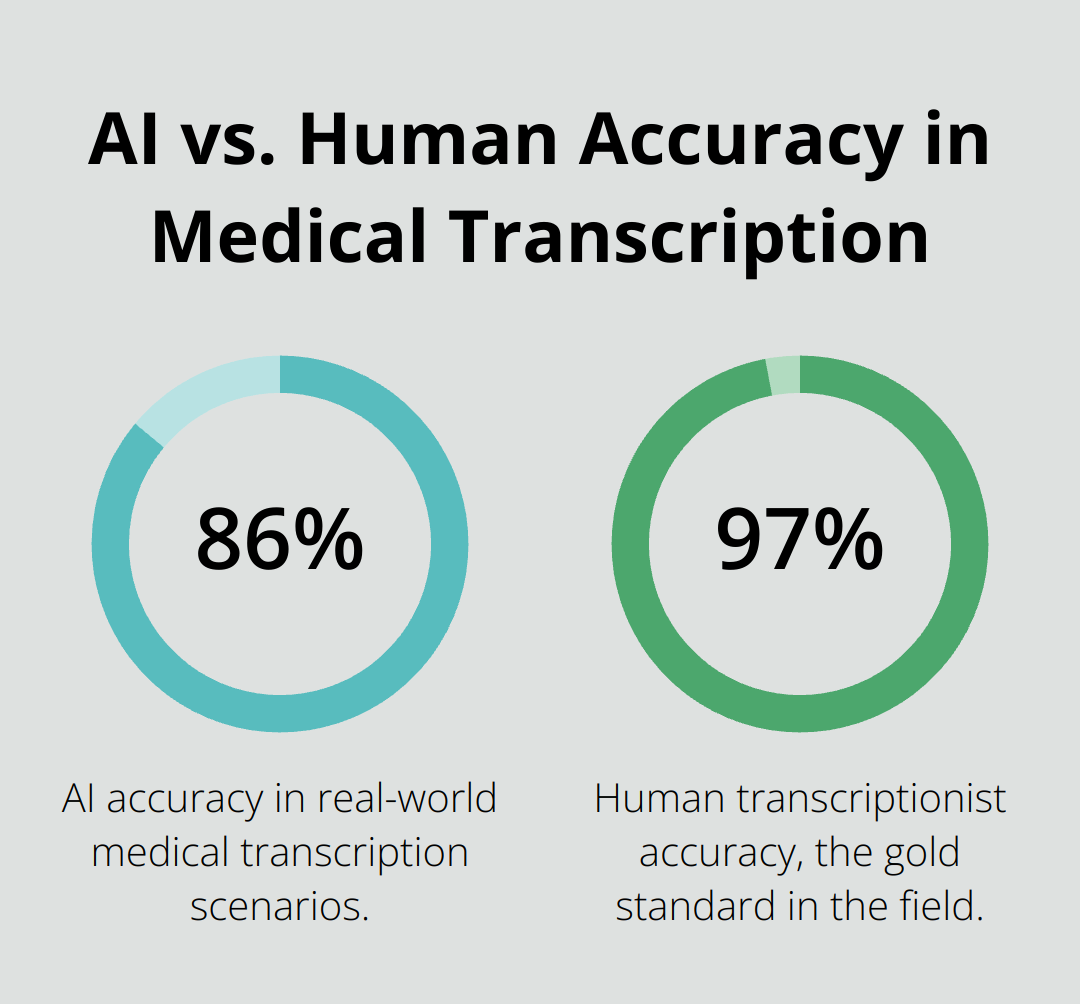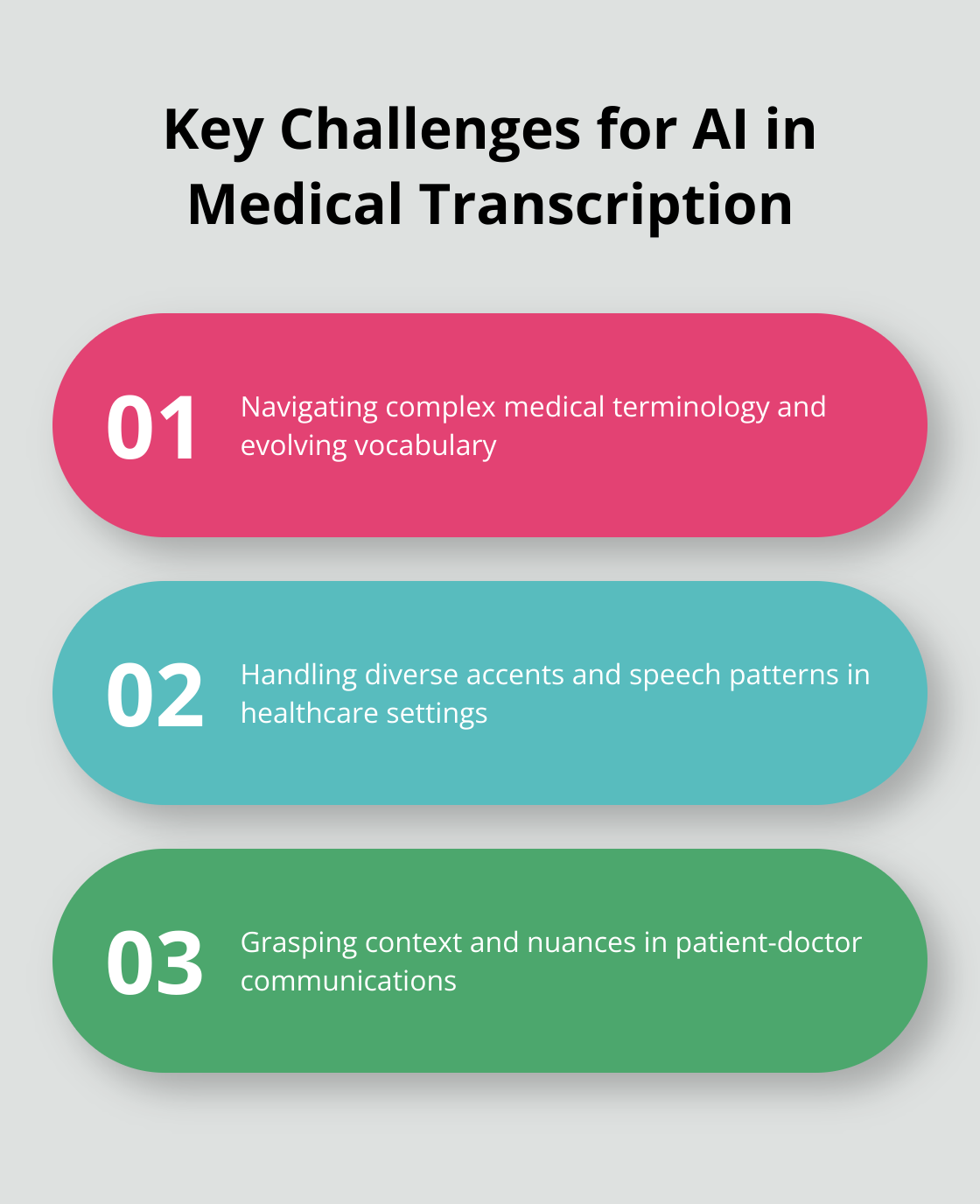AI accuracy in medical transcription—it’s the buzzword du jour in healthcare. At ScriberJoy, we’ve got a front-row seat to this AI-driven revolution that’s shaking up how medical records are crafted and handled… like, every day.
But, here’s the thing: can AI truly stack up against human transcriptionists when it’s crunch time—navigating those labyrinthine medical terms and the subtleties of patient interactions? (Spoiler: maybe not entirely.) This blog post dives into what AI can and can’t do in the realm of medical transcription—and why you still need that human touch to keep things ticking smoothly.
How Accurate is AI in Medical Transcription?
The Numbers Tell a Story
AI transcription in medicine-sounds futuristic, right? Well, slow your roll. Despite strides, it hasn’t yet flip-flopped human transcriptionists outta the picture. A reality check by Bergur Thormundsson in 2023 lays it bare: AI’s hitting just 86% accuracy in the wild. Compare that to the human gold standard of 97%-especially when the going gets complex or noisy-and you get the picture.

The Whisper Conundrum
Enter Whisper, the AI darling in healthcare circles. It’s like your favorite pair of jeans-popular, but not without their frays. Nearly 40% of its hallucinations are eyebrow-raising or downright sketchy, per Allison Koenecke’s research. Misrepresent the speaker? Uh… that’s a problem.
Real-World Applications
Yet, AI transcription is strutting around in healthcare. Take Mayo Clinic, flaunting speech recognition tech to cut EHR documentation time by a whopping 90%. But-and it’s a big but-human oversight probably has a starring role in this success.
The Human-AI Hybrid Approach
Blend AI with human smarts, and voilà-you’ve got the magic mix. This hybrid setup means docs get AI speed without losing the accuracy and context humans bring to the table. Some companies boast over 99% accuracy in medical transcription, leaving lone AI tools eating dust.
The Cost-Accuracy Trade-off
AI services like Whisper cost peanuts at $0.006 per audio minute, which is like catnip for budget-conscious healthcare facilities. But-there’s always a but-the risk of errors and need for human backup can gobble up those savings. Providers really have to weigh long-term costs against potential slip-ups when picking a transcription option.
The plot thickens. AI is carving out a spot in medical transcription, but what roadblocks are in its way? Let’s dig into what’s tripping up AI from fully hijacking the human throne in medical transcription.
Why AI Stumbles in Medical Transcription
AI transcription tools face big hurdles in the medical arena. Why? It’s the tangled complexity of healthcare lingo and the high-stakes nature of handling patient care.
The Jargon Jungle
Navigating the maze of medical terminology? Tough game for AI. Whisper, a popular transcription player thanks to its rock-bottom prices, is tripping up more than others in the voice recognition league. Lump that together with the ever-evolving medical vocabulary-new terms and acronyms popping up like mushrooms.
Accent and Speech Variability
Step into any healthcare setting, and it’s a stew of accents and speech styles. According to a 2022 American Medical Association survey, 21% of U.S. docs are international medical grads. This bountiful diversity is a gift for patient care, but a banana peel for AI transcription. Systems trained on plain vanilla American English? They trip and fall over diverse accents or regional tones.

And don’t forget the added twist of patient speech impairments. The National Institute on Deafness and Other Communication Disorders says nearly 7.5 million folks in the U.S. have voice troubles. When patients with conditions like dysarthria or aphasia step up to the mic, AI often flubs or skips crucial info.
Context is King
The ultimate Everest for AI in medical transcription? Grasping context. Medical chats are ripe with nuances, full of implied meanings and non-verbal signals that leave AI in the dust. A study seeks to dive into the digital health tools primary docs use and their patient impact.
And when AI misses the context, danger lurks. If a patient says “I feel like my heart is going to explode,” they’re likely metaphorical-but AI might take it at face value, sparking off-the-mark emergency alerts.
The Human-AI Synergy
AI hits these snags, yet cutting-edge solutions (like ScriberJoy) step up to the plate, tackling these challenges head-on. By blending AI’s rapid-fire abilities with human smarts, these hybrid approaches nail complex medical lingo, varied speech types, and subtle context. This teamwork nails down accuracy, leaving standalone AI solutions eating dust.
As we dig into the need for human oversight in medical transcription, it becomes clear-the AI-human duo is the golden road forward in this crucial field.

Why Human Oversight Remains Essential in Medical Transcription
The High Stakes of Medical Documentation
Medical records-think of them as the backbone of patient care. One wrong word, a twist in meaning… and boom, you’ve got chaos. Like that 2023 debacle where a hospital got slapped with a $140 million lawsuit-all because of a transcription slip-up that led to the wrong medication dose. Lesson here? Shooting for 99% accuracy in medical transcription isn’t just aiming high-it’s the baseline standard.
Bridging the AI-Human Accuracy Gap
So, AI transcription… yeah, not quite there. It lacks that contextual savvy (kind of a deal-breaker, right?), leading to clunky workflows. Humans, on the other hand, are nailing that 99% mark consistently. We’re talking more than just stats-it’s about keeping patients safe and healthcare top-notch. With human transcription, no vital info slips through the cracks.
The Importance of Context
Humans are masters of context, nuance, the stuff between the lines-where AI tends to stumble. In healthcare settings, precision isn’t negotiable. Take OpenAI’s Whisper tool-it’s got folks worried. Sure, the tech’s advanced, but it misses those subtle signals human transcriptionists catch, creating a truer picture of what happens between a patient and doctor.
Navigating Unpredictable Environments
Let’s be real-healthcare’s a bit of a circus for transcription tasks. Background noise, multiple voices, accents galore… AI gets tangled up. But humans? They cut through the noise with finesse, picking out what’s important and leaving out the extra fluff, so the final transcript is nothing but the essentials.
Continuous Improvement Through Feedback
Human oversight doesn’t just find mistakes-it turns them into AI’s growth moments. Every little fix by a human transcriptionist feeds into the AI, leveling up its game bit by bit. This human-AI tag team? It’s the sweet spot of accuracy and reliability in medical documentation.
We’re not here to boot humans and hand the reins to AI-nope. It’s all about building a dynamic duo where both shine. As we keep pushing forward, this mix of human and AI will set the gold standard in medical transcription accuracy and efficiency. (Oh, and if you’re after the best of both worlds, ScribeJoy’s got an approach that’s cutting-edge, hitting over 99% accuracy.)
Final Thoughts
So, AI has come in and basically flipped medical transcription on its head with speed and cost savings. But here’s the rub… 86% accuracy rates in real-world scenarios? Just not gonna cut it in a field where every word can matter. Enter the hybrid solutions-like ScribeJoy-that are winging it to over 99% accuracy by marrying algorithmic muscle with the good old human touch.
We’re gonna see AI strides in medical transcription tech, no doubt. Natural language processing? It’s primed to get sharper, picking up on context and wrestling with medical jargon like a pro. And don’t forget about machine learning-getting better at decoding all sorts of speech patterns and accents. But here’s the scoop: these advancements aren’t about booting humans out; they’re about teaming up.
The crystal ball? It’s showing a fusion of AI and human smarts steering the ship in medical transcription. This tech-human dance will serve up the precise, speedy, and context-packed documentation healthcare needs. Brace yourself-solutions like ScribeJoy, staying savvy with AI but soft with the human touch, are what the future of medical documentation looks like.

Leave a Reply
You must be logged in to post a comment.